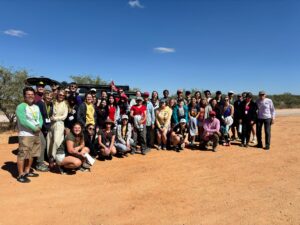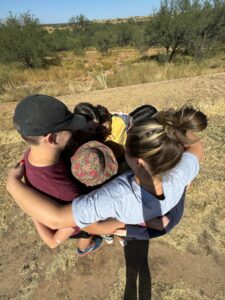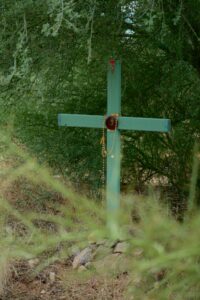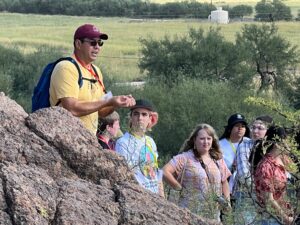L iminal space refers to a time or place between. It can be metaphorical like the time of transition our students are navigating. It can be a physical space, such as a hallway or staircase. Liminal space can be filled with excitement and anxiousness. It can be filled with apprehension and ambiguity. What has been and what might be are both very present. Such space can transform us and equip us for the future. I can also leave us grasping for something tangible – familiar – solid. As the HELM Leadership Fellows explored the Arizona border with Rev. Pedro Ramos Goycolea, it was clear that we were moving through a liminal space.
iminal space refers to a time or place between. It can be metaphorical like the time of transition our students are navigating. It can be a physical space, such as a hallway or staircase. Liminal space can be filled with excitement and anxiousness. It can be filled with apprehension and ambiguity. What has been and what might be are both very present. Such space can transform us and equip us for the future. I can also leave us grasping for something tangible – familiar – solid. As the HELM Leadership Fellows explored the Arizona border with Rev. Pedro Ramos Goycolea, it was clear that we were moving through a liminal space.
Pedro guided us through this history of colonization by the Spanish and how the symbol of the cross was followed by men with swords. He walked us through the ever-changing factions, forces, and nations that claimed dominion over the sacred land of his ancestors. We learned about the communities that formed in this region. Then, we got to see firsthand the harm that comes from trying to make liminal spaces tangible and rigid.
We visited Missions and learned the history of colonization. We heard stories of those who survived their migrant journey. We saw the crosses set in the desert to remember those whose journey ended in tragedy. While we listened to history, were inspired by stories, and learned how much pain the wall has created, we continued to see social media and political pundits spewing messages of division and fear.
Phyllis Tickle, in “the Great Emergence,” describes quadrants of Christian beliefs and practices. She predicts how they will, over time, listen to each other and impact each other. She describes a “gathering center” where people find common ground and imagine new paths forward – a liminal space. She also describes how many will fearfully cling to the corners, preferring to hold fast to the most extreme and rigid positions and shout down anyone who drifts too close to conversation with others.
The Christian Church (Disciples of Christ) is blessed to have diverse voices that speak from various theological positions, see the world through different cultural lenses, and proclaim the Gospel in their own voice. Our Leadership Fellows represent that diversity, and it was powerful to watch them each let go of their assumptions and fears and explore issues of immigration, economics, and environmental protection. Their questions, conversations and prayers represented the best of who our spiritual ancestors hoped we might become.
As we left Arizona, some students expressed the questions they will be wrestling with in the days ahead. Others expressed frustration with the national narratives around these sacred lands and wondered how they might cut through the misinformation to share what they saw. All of us knew that no matter how far away our home might be, the land of the Tohono O’odham people is not done with us. This land and our experience has now become a part of us that will stay with us forever.
The stories we learned, the people we met, and the sacred space we visited will change the way we read the news and the Bible. They will change the way we receive “news” and inspire us to make some news of our own. We leave the liminal space of the border and enter the liminal space of our nation during elections. We enter the liminal space of our churches as they look to the future. We give thanks for the liminal space of our students as they seek God’s guidance into the future.
This is what we do. This is what HELM is all about. We accompany our students on this journey and provide them with the resources of the Church. We accompany the Church and amplify the voices of students who are not afraid to walk into the unknown and undefined spaces – the border between what was and what the Church might become. HELM stands as a liminal space where faith and reason – teachers and students – mentors and leaders come together to change the world.




